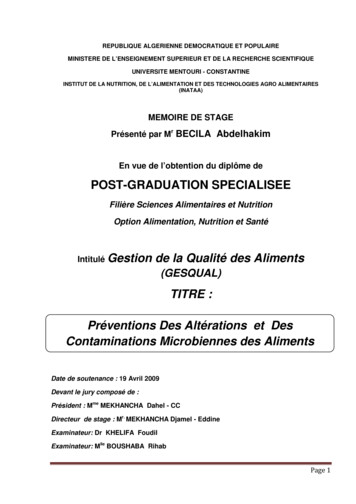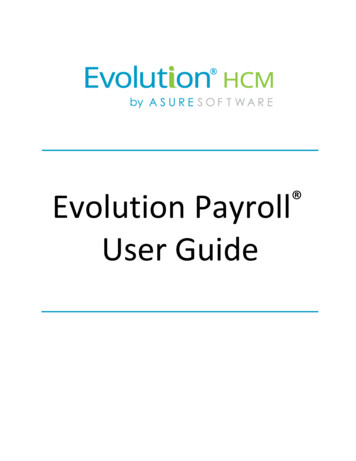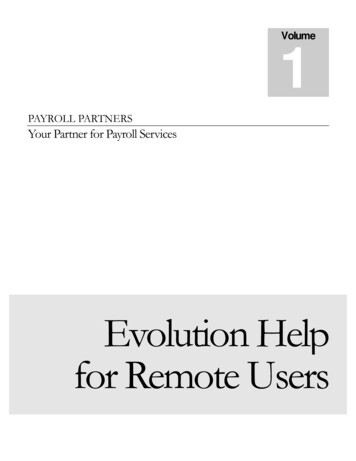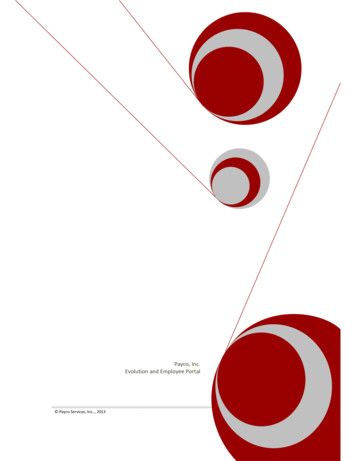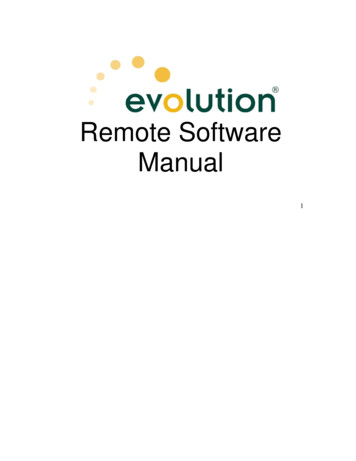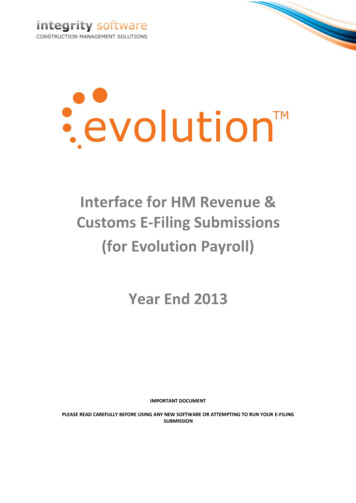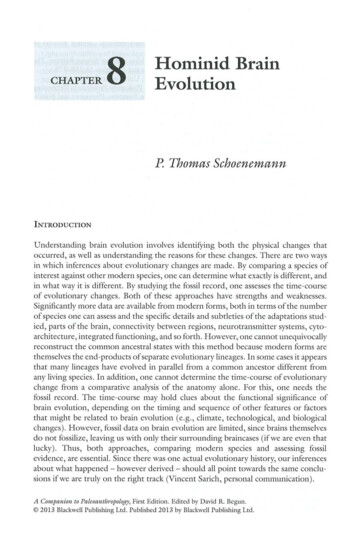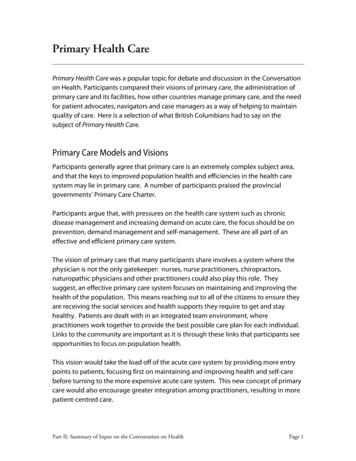
Transcription
CHAPTER1Introduction: The Evolutionof Health InformaticsRamona NelsonOver time the collaborative opportunities to create a more effective and efficienthealthcare system will become more interesting and motivating than the historicalstruggles and hierarchical relations of the past.OBJECTIVESAt the completion of this chapter the reader will beprepared to:1. Analyze how historical events have influenced thedefinition and current scope of practice of healthinformatics in healthcare2. Discuss the development of health informatics as adiscipline, profession, and specialty3. Analyze informatics-related professional organizationsand their contributions to professional development andinformaticsKEY TERMSBiomedical informatics, 13Clinical informatics, 11Computer science, 3Dental informatics, 6Health informatics, 2ABSTRACTHealth informatics has evolved as both a discipline or field ofstudy and an area of specialization within the health professions. This chapter describes the historical process of thatevolution as a basis for understanding the current status ofhealth informatics as both a discipline and a specialty withinhealthcare. The historical roots within computer and information science are explored. The development of professionalorganizations, educational programs, and the knowledge baseas documented in conference presentations, proceedings,journals, and books is described. The history of and processfor naming the specialty and the discipline are then analyzed.INTRODUCTIONHealth informatics has evolved as a discipline and an area ofspecialization within the health professions. As both a practice specialty and a field of study, health informatics2Informatics, 4Information science, 3Medical informatics, 5Nursing informatics, 6incorporates processes, procedures, theories, and conceptsfrom computer and information sciences, the health sciences (e.g., nursing and medical science), and the social sciences (e.g., cognitive and organizational theory). Healthinformatics professionals use the tools of information technology to collect, store, process, and communicate healthdata, information, knowledge, and wisdom. The goals ofhealth informatics are to support healthcare delivery andimprove the health status of all. Information technology andrelated hardware, as well as software, are viewed as tools to beused by consumers, patients, and clients; healthcare providers; and administrators in achieving these goals. Health informatics incorporates processes, procedures, theories, andconcepts from a number of different health professions and istherefore a unique interprofessional field of study as well asan area of specialization within the different health professions. This chapter explores the evolution of health informatics as both a discipline and a specialty practice withinhealthcare.
CHAPTER 1 Introduction: The Evolution of Health InformaticsTHE ROOTS OF INFORMATICS WITHIN THECOMPUTER AND INFORMATION SCIENCESHealth informatics emerged as a distinct specialty withinhealthcare over time as nurses, physicians, and other healthcare visionaries applied innovative developments in the computer and information sciences to complex problems inhealthcare. Computer science brings to health informatics thetechnology and software coding required for this specialtywhile information science contributes the procedures andprocesses needed to develop and process data, information,and knowledge. The health professions provide the knowledge and wisdom to use computer and information scienceeffectively in delivering healthcare and improving the healthof all people. Understanding the scope and boundaries ofhealth informatics begins with an appreciation of its rootswithin computer and information sciences.Computer ScienceComputer science is defined as the “systematic study of algorithmic methods for representing and transforming information, including their theory, design, implementation,application, and efficiency . . . The roots of computer scienceextend deeply into mathematics and engineering. Mathematics imparts analysis to the field; engineering impartsdesign.”1(para 1) The word computer is derived from the Latinword computare, which means to count or sum up. The wordfirst appeared in English in 1646, meaning a person whocomputes or processes mathematical data.However, a key problem with these early human computers was that they made errors. In the early 1800s, CharlesBabbage, a mathematician, became increasingly concernedwith the high error rate in the calculation of mathematicaltables. Impressed by existing work on calculating machines,he proposed the development of a “difference engine.” As aresult of his efforts to create a general-purpose, programmable computer employing punch cards, he is often identified as the first person to create a nonhuman computer or aprogrammable mechanical device aimed at solving problems.2 While Babbage was not successful in building a functioning computer, the process of using punch cards to inputdata and obtain output did become an effective technologyin other fields, such as rug making.The Babbage approach to creating a computer includedinput and output but not storage. Herman Hollerith took thisidea a step forward in the late 1800s when he used punchcards for input, processing, creating output, and storingdata. Hollerith, like Babbage, was motivated by his concernwith laborious, time-consuming, and error-prone humanoperations. In Hollerith’s case, the problems were evidentin the processes used for collecting and calculating the1880 U.S. census and related data. His invention, whichboth sorted and tabulated data, “was the first wholly successful information processing system to replace pen andpaper.”3(para 2) In 1896, starting with this and related inventions, Hollerith founded the Tabulating Machine Company.In 1911 the Tabulating Machine Company merged with two3other companies, creating the company that is now IBM.Hollerith’s technology, developed for completing the U.S.census for 1890, was used well into the 1960s. By the 1960sautomation was becoming part of healthcare and healthinformatics was beginning to emerge as a new discipline.The move from a mechanical to an electronic digital computer is usually dated to the creation of ENIAC (ElectronicNumerical Integrator and Computer) in the 1940s. This wasa large machine requiring huge amounts of space, a specialized environment, and specially trained personnel. It initiatedthe concept of centralized computing and the informationservices department. Twenty years after ENIAC began functioning, the first Department of Computer Sciences in theUnited States was established in 1962 at Purdue Universitywithin the school’s Division of Mathematical Sciences.4The foundational relationship between the science of mathematics and the development of computer science providescertain benefits for health informatics. The culture of mathematics brings to the study of informatics systematic, logicalapproaches, processes, and procedures for understandingnatural phenomena and solving problems.In the 1980s the personal computer (PC) emerged andforever changed the role of the user as well as the organizational infrastructure for supporting computerization withininstitutions. Computerization within healthcare institutionswas no longer totally centralized and computer use was nolonger limited to specially trained personnel. As healthcareproviders became direct users of the computer, they beganto discover a wide range of new uses for these tools. Theincreased interest in the value of computers and the increasedlevel of computer literacy among a number of healthcareproviders proved a major advantage to the creation of theinformatics specialty. These same factors have also created acertain tension between centralized and decentralized infrastructures to support technology within healthcare settings.Information Science“Information science is a discipline that investigates theproperties and behavior of information, the forces governingthe flow of information, and the means of processing information for optimum accessibility and usability. It is concerned with that body of knowledge relating to the origination,collection, organization, storage, retrieval, interpretation,transmission, transformation, and utilization of information.This includes the investigation of information representations in both natural and artificial systems, the use of codesfor efficient message transmission, and the study of information processing devices and techniques, such as computersand their programming systems.”5(p3)Establishing the beginning of information science isdifficult since it emerged from the convergence of variousdisparate disciplines, including library, computer, communication, and behavioral sciences.6 However, there are key datesand events that can be used to demonstrate the evolutionof information science as a distinct specialty whose rootsextend deeply into the profession of library science. Theseinclude the following:
4UNIT 1Background and Foundational Information In 1937 the American Documentation Institute (ADI) wasestablished. The initial organizational focus was the development of microfilm as an aid to information dissemination. Because of the expansion and diversification of itsmembers, ADI changed its name to the American Societyfor Information Science in 1968 and then to the AmericanSociety for Information Science and Technology in 2000.7 In 1948 the Royal Society of Great Britain held a conference bringing together “libraries, societies, and institutions responsible for publishing, abstracting, andinformation services to examine the possibility of improvement in existing methods of collection, indexing,and distribution of scientific literature, and for the extension of existing abstracting services.”8(p136) The decisionby this prestigious group to hold such a conferencedemonstrated the growing importance of managinginformation. In 1963 the first textbook that treated information scienceas a discrete discipline was published. The book wastitled Information Storage and Retrieval: Tools, Elementsand Theories.6 In 1964 the National Library of Medicine (NLM) beganusing the computerized MEDLARS (Medical LiteratureAnalysis and Retrieval System) as a mechanism to createIndex Medicus.9 In 1971 the NLM began offering national online access toMEDLINE. In 1972 the NLM began training physicians and otherhealth scientists in the use of computer technology formedical education and the provision of healthcare. Thiswas the beginning of its informatics training programs.10The NLM would go on to play a major role in the development of the health informatics specialty.The relationship between library science and the development of information science provides certain benefits forhealth informatics. The culture of library science brings tothe study of informatics policies and procedures for managing information, an awareness of the value of the informationto the user of that information, and a culture of service.Evidence of this cultural value can be inferred from theguiding principles of the American Library Association outlined in Box 1-1.Health InformaticsThe development of health informatics is usually traced tothe 1950s with the beginning uses of computers in healthcare.11 This early period in the history of informatics extendedinto the 1960s and was characterized by experimenting withthe use of this new technology in medicine and in nursingeducation.12 For example, Robert Ledley, a dentist interestedin biomedical research, published with Lee Lusted one of thefirst papers in this field. The paper, titled “Reasoning Foundations of Medical Diagnosis,” discussed computer-basedmedical diagnosis.13 Ledley went on to invent the computedtomography (CT) scanner in the 1970s. An example fromnursing is the work of Connie Settlemeyer, a graduate studentin the University of Pittsburgh School of Nursing in the lateBOX 1-1AMERICAN LIBRARYASSOCIATION: GUIDINGPRINCIPLESAdvocacy for Libraries and the ProfessionDiversityEducation and Lifelong LearningEquitable Access to Information and Library ServicesIntellectual FreedomLiteracyOrganizational ExcellenceTransforming Libraries in a Dynamic and Increasingly GlobalDigital Information EnvironmentTABLE 1-1CHARTING USING THESOAPE FORMATLETTERITEMDESCRIPTIONSSubjectivedata orobservationsData provided by the patient,family, or others that cannotbe observed, such as painOObjectivedata orobservationsData that can be observed,such as the condition of anincision (inflamed, openwith purulent drainage)AAssessmentThe conclusion, diagnosis, orinterpretation of the data,such as wound infectionPPlanA list of goals and plannedinterventionsEEvaluationA description of theoutcomes or responses tothe interventions1960s. Settlemeyer designed a mainframe-based computerassisted instruction program for teaching students how tochart using the common problem-oriented format referredto as SOAPE or SOAP. See Table 1-1 for an overview of thisformat. This program was then used to teach undergraduatenursing students at the University of Pittsburgh throughoutthe 1970s.During this same period the term informatics was established. Informatics is actually the English translation ofterms used in other languages. Because of differences in language it is difficult to determine whether the initial use of theword informatics was referring to the discipline of informatics, information science, computer science, or a combinationof these. A.I. Mikhailov at Moscow State University is creditedwith first using the Russian terms informatik and informatikii.In 1968, Mikhailov published the book Oznovy Informatiki,which was translated as Foundations of Informatics. In 1976,he published a second book, Nauchnye Kummunikatsii iInformatika, which was translated as Scientific Communication and Informatics. In this book he defined informatics asthe science that “studies the structure and general propertiesof scientific information and the laws of all processes of scientific communication.”14(p39)
CHAPTER 1 Introduction: The Evolution of Health InformaticsESTABLISHING THE SPECIALTY OFHEALTH INFORMATICSOver the next several decades, evidence that a new specialtywas being established can be seen in the following:1. Publications of health informatics books2. Development of new journals3. Establishment of professional organizations4. Number of informatics conferences that are now recurringevents5. Creation of university-level educational programs6. Development of certification programsThe history of each of these activities contributed to thedevelopment of the knowledge base that is unique to thediscipline. Over time a result of these activities is an organizedbody of knowledge that is specific to the discipline. Thenewest information within the discipline is often presentedat conferences. While a conference may have a theme andeven subthemes, the focus is on presenting the newest information and not an organized body of knowledge. “The timeliest articles on computer applications in medicine [are]found in proceedings and transactions of meetings sponsoredby professional and commercial organizations.”14(p46) As journals develop, the information and knowledge specific to thediscipline become more established and organized. As theknowledge increases, the organizational structure of thatknowledge is recognized and accepted within the discipline.At this point in the development of any discipline, includinghealth informatics, books play a key role in presenting theknowledge of the discipline in an organized format. Forexample, scan the table of contents of this book and noticethe overall organization of the knowledge specific to thisdiscipline. This general pattern of increasing organizationwithin publications over time is demonstrated in Figure 1-1.As the discipline matures, these elements intersect with conferences and journal material coinciding and then feedingmore formal material to books.BooksBooks related to computers and healthcare began appearingin the 1960s. Examples of these types of books are includedin Box 1-2. However, the use of the word informatics in aBOX 1-2EARLY BOOKS ON COMPUTERSAND HEALTHCAREComputer Applications in the Behavioral Sciences (1962) byHarold BorkoComputer Applications in Medicine (1964) by Edward EatonMason and William G. BulgrenUse of Computers in Biology and Medicine (1965) by RobertSteven Ledley with the assistance of James Bruce WilsonComputers in Biomedical Research (1965) by Ralph W. Stacyand Bruce D. WaxmanOrganization of the KnowledgeIn the 1960s the word informatique began to appear in theFrench literature. Informatique translates to English as informatics or computing, data processing, or the handling ofinformation, especially by a computer. During these sameyears the German term informatik was used. Informatik translates as meaning computing, calculating, figuring, or reckoning. The term medical informatics began to appear in Englishpublications in the early 1970s. While the term medicalinformatics was not explicitly defined in these initial publications, it was generally accepted to mean the use of a computerto process medical data and information.14While the period previous to the 1970s was characterizedby experimentation and the establishment of the term informatics, the next 10 to 15 years were characterized by thebeginning use of computers in actual patient care and thedevelopment of health informatics as a discipline. Beginningin 1971, El Camino worked in partnership with Lockheed toinstall the world’s first computer-aided medical informationsystem, known as MIS.15 A number of hospitals followed thisexample by installing information systems to manage business and inventory data.At that time nurses, and unit secretaries under the direction of nurses, were responsible for completing the paperforms necessary to implement physicians’ orders that hadbeen handwritten on patients’ charts. These paper forms wereused to communicate the orders to other departments and tocapture the hospital charges associated with these orders. Asa result, the functions of “order entry” and “results reporting”were in some of the first hospital information systems withdirect patient care implications. Nurses, along with employees in specialty departments such as labs and radiology, weresome of the first healthcare providers directly affected by theuse of this technology in healthcare. During this same decadecomputers were beginning to be used in specialty areas suchas the cardiac lab as hemodynamic monitoring systems. Inthese environments computers were used to do calculations,returning accurate results within seconds. By the end of the1970s both commercial and academic developments in computers, libraries, and healthcare had created a fertile environment for the growth and development of the new disciplineof health informatics.5BooksJournalsConference proceedingsAge of the InformationFIG 1-1 General trends in the development of knowledgewithin a discipline.
6UNIT 1Background and Foundational Informationbook title did not appear until 1971 when the InternationalFederation for Documentation published An IntroductoryCourse on Informatics/Documentation by A.I. Mikhailov andR.S. Giljarevskij. This was followed in 1977 by Informatics andMedicine: An Advanced Course, edited by P.L. Reichertz andG. Goos. In the 1980s books related to computers and nursingbegan to appear. The first of these books, Nursing InformationSystems by Werley and Grier, established and explained theminimum data set in nursing practice.16 This was quicklyfollowed by one of the classic publications in informatics,Computers in Nursing by Rita Zielsorff.17The 1980s were characterized by several publicationsdealing with computers and nursing. Well-recognized examples include the first edition of Essentials of Computers byVirginia Saba and Kathleen McCormick in 1987 and Guidelines for Basic Computer Education in Nursing by Diane Skibaand Judith Ronald. In 1988 the first book using the termnursing informatics in its title was published. This book,authored by Ball, Hannah, Newbold, and Douglas, was titledNursing Informatics: Where Caring and Technology Meet.18 In1990 one of the first medical informatics textbooks, titledMedical Informatics: Computer Applications in Health Careand Biomedicine, was published by Shortliffe, Perreault,Wiederhold, and Fagan.19 In this same year the first dentalinformatics book, Dental Informatics: Strategic Issues for theDental Profession, part of the series Lecture Notes in MedicalInformatics, was edited and published by John J. Salley,John L. Zimmerman, and Marion Ball. Today most if notall of the major publishers in the healthcare arena publishbooks related to health informatics. A search of offerings onAmazon or the Books in Print database can result in well over1000 hits. However, because different editions, as well ashardback and paperback editions, are counted as separatebooks, it is impossible to get an accurate count of the totalnumber of informatics books now in print. See Table 1-2for a brief book list.TABLE 1-2JournalsNAMEFollowing the same pattern as books, new journals began tobe published in the 1960s and used the word computer asopposed to informatics. Homer Warner at the University ofUtah edited the first peer-reviewed journal within the newdiscipline. This journal, titled Computers in BiomedicalResearch, began publishing in 1967.14 Table 1-3 includes thenames and beginning dates of other initial health informaticsjournals from this time period.In 1982, the first edition of the journal Computers inNursing was published as a newsletter. The newsletter becamean official journal published by Lippincott in 1984. Today thejournal is known as CIN: Computers Informatics Nursing.While these journals provided a publishing resource for theevolving discipline, articles were also being published in otherprofessional journals. In 1960, a total of 38 articles wereindexed under the subject “computers in medicine.”14 Sincethat date close to 15,000 articles have been indexed inMEDLINE and CINAHL using the key word “informatics.”Computers andMedicine1972American MedicalAssociationJournal of ClinicalComputing1972Gallagher PrintingJournal of MedicalSystems1977Plenum PressMD Computing 19831983Springer-VerlagEXAMPLES OFINFORMATICS BOOKSAUTHORS OREDITORSTITLEEDITION ANDDATE ons inHealth Care andBiomedicineEdward H.Shortliffe andJames J.Cimino3rd edition,2006Health Informatics:Practical Guide forHealthcare andInformationTechnologyProfessionalsRobert E. Hoyt,Nora Bailey,and AnnYoshihashi5th edition,2012InformationTechnology for theHealth ProfessionsLillian Burke andBarbara Weill3rd edition,2008Essentials ofNursingInformaticsVirginia Saba andKathleenMcCormick5th edition,2012Introduction toComputers forHealthcareProfessionalsIrene Joos,RamonaNelson, andMarjorie J.Smith5th edition,2010Informatics andNursing:Opportunities andChallengesJeanne Sewelland LindaThede4th edition,2013TABLE 1-3EARLY JOURNALS INHEALTH INFORMATICSBEGINNINGDATEPUBLISHERWhile the term informatics began appearing in the titles ofarticles in the early 1970s, it was not until 1986 that the firstjournal article using the term nursing informatics was indexedin MEDLINE as well as CINAHL. This article, titled “The NIPyramid—A Model for Research in Nursing Informatics,”presented a model for research in nursing informatics.20 Thismodel is described in Chapter 2 of this book. As with books,the number of journals has expanded significantly. As of
CHAPTER 1 Introduction: The Evolution of Health InformaticsSeptember 2012 the NLM catalog of journals included 119informatics journals. Fifty-four of these journals are referenced in the National Center for Biotechnology Information(NCBI) database. Updated numbers can be seen by searchingthe database online at www.ncbi.nlm.nih.gov/nlmcatalog.Note that not all of the referenced journals are traditionalprint journals. The Online Journal of Public Health in/ojs/index.php/ojphi/index), established in 2009, is and always has been anonline journal. The journals in this growing database reflectthe overall field of informatics as well as subspecialties withininformatics. For example, one of the journals indexed inMEDLINE—CIN: Computers Informatics Nursing—is specific to nursing informatics. The proceedings from the International Medical Informatics Association (IMIA) NursingInformatics Conferences were added to this list starting inlate 2012.Professional OrganizationsMany of the early practitioners interested in the field ofhealth informatics soon discovered there were no formal education programs or colleagues in their professional associations and local community who were also interested in thegrowing impact of computers. As a result, beginning in thelate 1960s and early 1970s, professional organizations beganto emerge, playing a significant role in the development ofthis specialty and providing a major source of education andnetworking for these early pioneers.21 Initially informaticsgroups formed within other larger professional groups. Forexample, the American Medical Association (AMA) formeda committee on computers in medicine in 1969.14 As theseinitial efforts expanded, professional organizations focusedon health informatics began to split off from the larger organizations. At the same time that national and internationalgroups were being established, a number of health informatics groups were established as smaller local groups.The 1980s were a key decade for these activities. IMIA,which was established in 1967 as a technical committee of theInternational Federation for Information Processing (IFIP),became an independent organization in 1987. Prior to this,IMIA established Working Group 8 on Nursing Informaticsin 1981 with representatives from 25 countries. The IMIANursing Informatics group continues to this day as aspecial interest group within IMIA. In the United States, theSymposium on Computer Applications in Medical Care(SCAMC) merged with the American Association for MedicalSystems and Informatics (AAMSI) and the American Collegeof Medical Informatics (ACMI) in 1989 to become theAmerican Medical Informatics Association (AMIA). AMIAestablished a Special Interest Group: Computers in Nursingin the same year.In 1986 the Hospital Management Systems Society(HMSS), an affiliate of the American Hospital Association(AHA), became the Healthcare Information and Management Systems Society (HIMSS), reflecting the growinginfluence of information systems and telecommunications7professionals within HIMSS as well as healthcare. In 1993HIMSS became an independent, not-for-profit corporation.22The American Nurses Association (ANA) establishedthe Council on Computer Applications in Nursing in 1984,and the National League for Nursing (NLN) establishedthe National Forum on Computers in Health Care andNursing. Beginning in the 1980s and continuing over thenext three decades, several local nursing informatics groupswere formed. One of the largest and best known of theseorganizations is the Capital Area Roundtable on Informaticsin Nursing (CARING) established in 1982. In 2010, theAmerican Nurses Informatics Association (ANIA) from California and CARING from Washington, D.C. merged, creatingANIA-CARING, a national nursing informatics organizationthat includes five regions. With more than 3000 membersin 34 countries and 50 states, ANIA is one of the largestnursing informatics organizations in existence.23 Today anumber of other local or regional nursing informatics groupscontinue to exist. In 2004, realizing the advantage of collaboration between these different nursing groups, 18 nationaland regional nursing informatics groups established the Alliance for Nursing Informatics (ANI) with the financial andleadership support of AMIA and HIMSS.24 As of July 2012,there were 30 member groups. Box 1-3 lists examples of ANI’saccomplishments.An additional major informatics organization is theAmerican Health Information Management Association.This Association has taken a slightly different path than theother significant informatics-related organizations. In 1928the Association of Record Librarians of North America(ARLNA) was formed. One of the goals of this new organization was to improve the record of care provided to patientsthrough the use of standards. Professionals within ARLNAwere titled as registered record librarians (RRLs). In themid-1940s the association changed its name to the AmericanAssociation of Medical Record Librarians (AAMRL). However, this was not the last name change. As medical recordsBOX 1-3EXAMPLES OF THE ALLIANCEFOR NURSING INFORMATICS’ACCOMPLISHMENTSSuccessfully asked Google to appoint a nurse to the GoogleHealth Advisory Council.Worked closely with Technology Informatics Guiding Educational Reform (TIGER) initiative to increase the knowledgeand awareness of students and practicing nurses concerning informatics.Provided expert testimony for the Institute of Medicine andthe Robert Wood Johnson forum on the Future of Nursing.Recommended numerous nursing experts for service onnational committees and expert panels.Submitted comments to the National Institute of Standardsand Technology (NIST) on Usability Framework as well asa number of other such documents.
8UNIT 1Background and Foundational Informationwere increasingly computerized and as members assumedincreasing responsibility within that process, the emphasis oninformation management became obvious. In 1991 theAAMRL changed its name to the American Health Information Management Association (AHIMA).25 Today, AHIMAcontinues to play “a leadership role in the effective management of health data and medical records needed to deliverquality healthcare to the public.”26 Box 1-4 lists the majorhealth informatics organizations and includes additionalinformation on nursi
Introduction: The Evolution of Health Informatics Ramona Non lse CHAPTER 1 Over time the collaborative opportunities to create a more effective and effi cient . journals, and books is described. The history of and process . Information technology and related hardware, as well as
